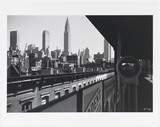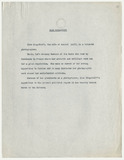Ilse Bing
Ich wünsche es niemandem, aber im Endergebnis habe ich gewonnen. Ich habe viel Materielles verloren, aber menschlich bin ich gewachsen.
[I wouldn’t wish it on anyone, but in the end, I won. I lost many material things, but I grew as a human being. (ed. trans.)]
Ilse Bing in an interview she gave in 1989, in which she talked about her experiences of internment and persecution in France after the German military forces invaded the country in 1940
| Born | on 23 March 1899 in Frankfurt am Main |
|---|---|
| Died | on 30 March 1998 in New York, USA |
| Exile | France, United States of America |
| Profession | Photographer |
Ilse Bing found her way to photography while she was studying art history. Her early works included photographs of the avant-garde buildings constructed for the urban development programme Das neue Frankfurt (The New Frankfurt), which got under way in the mid-1920s under the direction of architect Ernst May.
In 1930, Bing moved to Paris to work as a photographer. She quickly made a name for herself with her experimental street scenes and fashion photography. Her works were published in the German and French press and in American magazines such as Vogue and Harper’s Bazaar. After the Nazis came to power in 1933, Bing turned down all requests from German newspapers. At times, she had to coach students to compensate for her financial losses.
After World War II broke out, Ilse Bing and her husband, pianist Konrad Wolff, were classified as “enemy aliens” and interned for several months. After their release, they settled in France’s unoccupied territory; however, as Jews, they were still threatened with persecution by the Germans. In June 1941, they managed to escape to the USA with the help of the Emergency Rescue Committee (ERC). As a result of this forced emigration, Bing lost a large part of her works.
After some time, the artist was no longer able to find any inspiration in New York for her further development as a photographer. At the end of the 1950s, she gave up photography and turned to painting and literature. Her photographic oeuvre was rediscovered during the mid-1980s and now enjoys international acclaim.
Further reading:
Jüdische Portraits. Photographien und Interviews von Herlinde Koelbl [Jewish Portraits. Photographs and Interviews by Herlinde Koelbl], Frankfurt am Main: S. Fischer, 2010, pp. 25-28.
Unda Hörner: Scharfsichtige Frauen. Fotografinnen der 20er und 30er Jahre in Paris [Sharp-eyed Women. Photographers of the 1920s and 30s in Paris], Berlin: Edition Ebersbach, 2010





